1995 CHEVROLET TAHOE towing
[x] Cancel search: towingPage 273 of 486
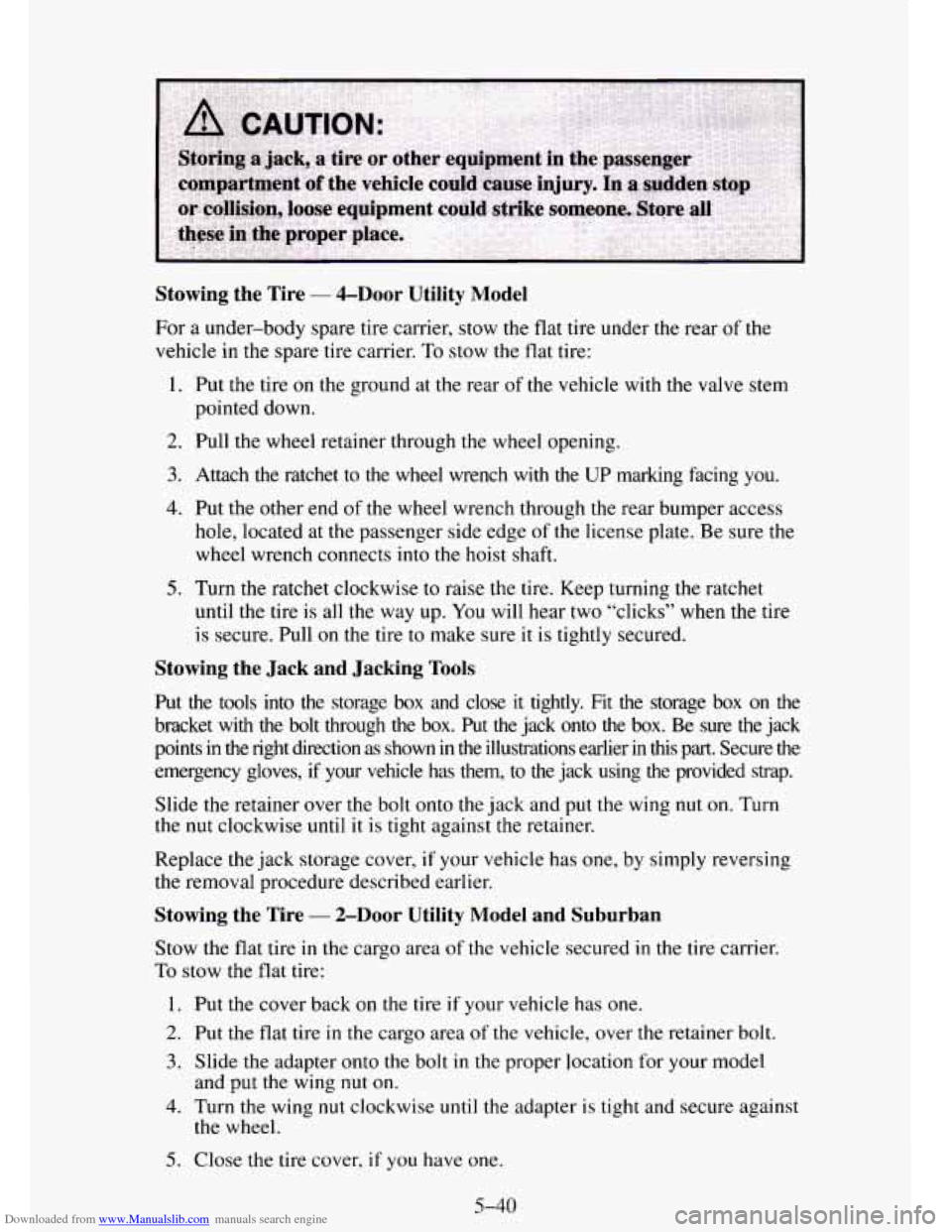
Downloaded from www.Manualslib.com manuals search engine Stowing the Tire - &Door Utility Model
For a under-body spare tire carrier, stow the flat tire under the rear of the
vehicle in
the spare tire carrier. To stow the flat tire:
1. Put the tire
on the ground at the rear of the vehicle with the valve stem
2. Pull the wheel retainer through the wheel opening.
pointed
down.
3. Attach the ratchet to the wheel wrench with the UP marking facing you.
4. Put the other end of the wheel wrench through the rear bumper access
hole, located at the passenger side edge of the license plate. Be sure the
wheel wrench connects into the hoist shaft.
5. Turn the ratchet clockwise to raise the tire. Keep turning the ratchet
until the tire
is all the way up. You will hear two “clicks” when the tire
is secure. Pull on the tire to make sure
it is tightly secured.
Stowing the Jack and Jacking Tools
Put the tools into the storage box and close it tightly. Fit the storage box on the
bracket with the bolt through the
box. Put the jack onto the box. Be sure the jack
points in
the right direction as shown in the illustrations earlier in this part. Secure the
emergency gloves, if your vehicle has them, to the jack using the provided strap.
Slide the retainer over the bolt onto the jack and put the wing
nut on. Turn
the nut clockwise until it is tight against the retainer.
Replace the jack storage cover, if your vehicle has one, by simply reversing
the removal procedure described earlier.
Stowing the Tire - 2-Door Utility Model and Suburban
Stow the flat tire in the cargo area of the vehicle secured in the tire carrier.
To stow the flat tire:
1. Put the cover back on the tire
if your vehicle has one.
2. Put the flat tire in the cargo area of the vehicle, over the retainer bolt.
3. Slide the adapter onto the bolt in the proper location for your model
4. Turn the wing nut clockwise until the adapter is tight and secure against
and
put
the wing nut on.
the wheel.
5. Close the tire cover, if you have one.
5-40
Page 274 of 486
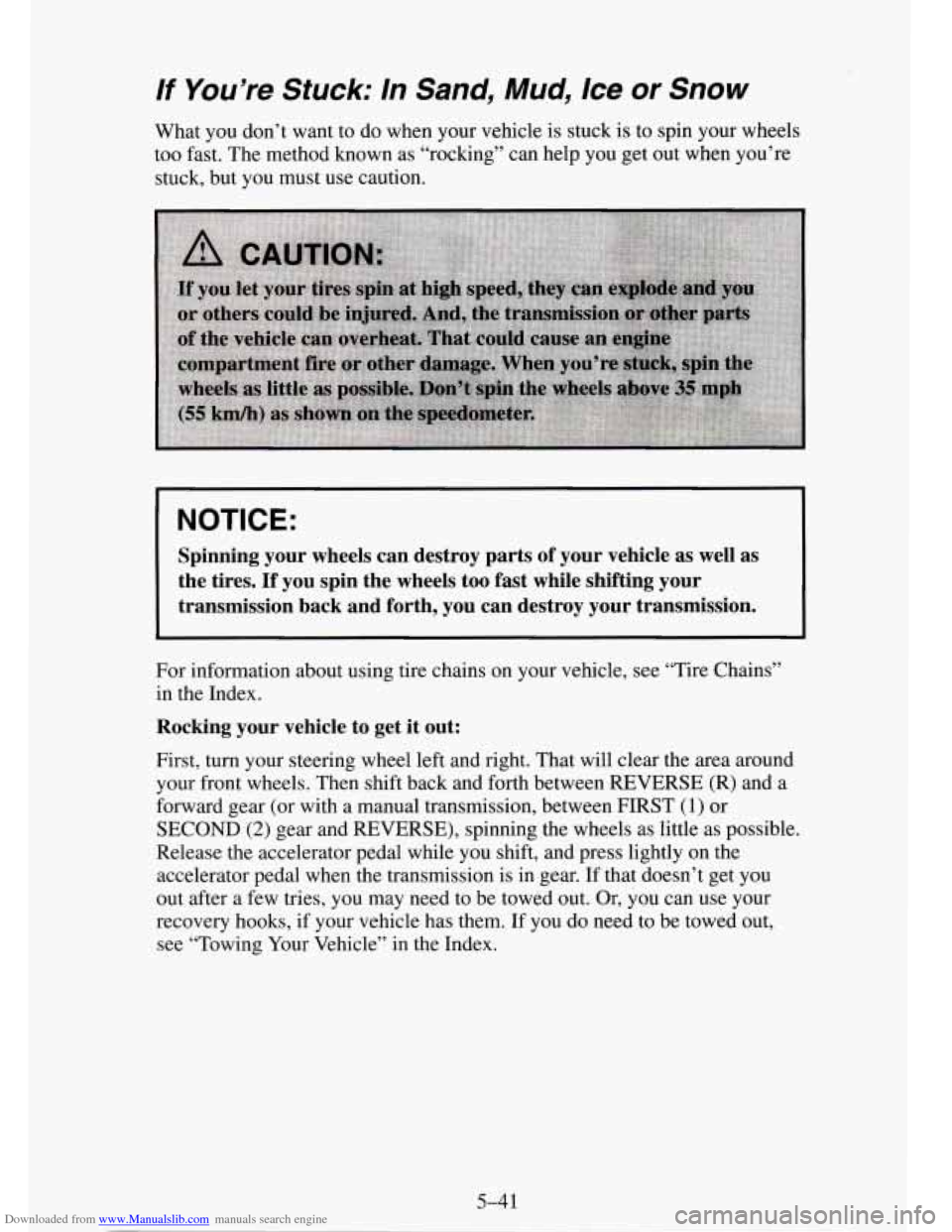
Downloaded from www.Manualslib.com manuals search engine If You’re Stuck: In Sand, Mud, /ce or Snow
What you don’t want to do when your vehicle is stuck is to spin your wheels
too fast. The method known as “rocking” can help you get out when you’re
stuck, but you must use caution.
I NOTICE:
Spinning your wheels can destroy parts of your vehicle as well as
the tires. If you spin the wheels too fast while shifting you\
r
transmission back and forth, you can destroy your transmission. \
For information about using tire chains on your vehicle, see “Tire Chains”
in the Index.
Rocking your vehicle to get it out:
First, turn your steering wheel left and right. That will clear the area around
your front wheels. Then shift back and forth between REVERSE (R) and a
forward gear (or with a manual transmission, between FIRST
(1) or
SECOND
(2) gear and REVERSE), spinning the wheels as little as possible.
Release the accelerator pedal while you shift, and press lightly on the
accelerator pedal when the transmission
is in gear. If that doesn’t get you
out after a few tries, you may need to be towed out. Or, you can use your
recovery hooks,
if your vehicle has them. If you do need to be towed out,
see “Towing Your Vehicle” in the Index.
5-41
Page 375 of 486
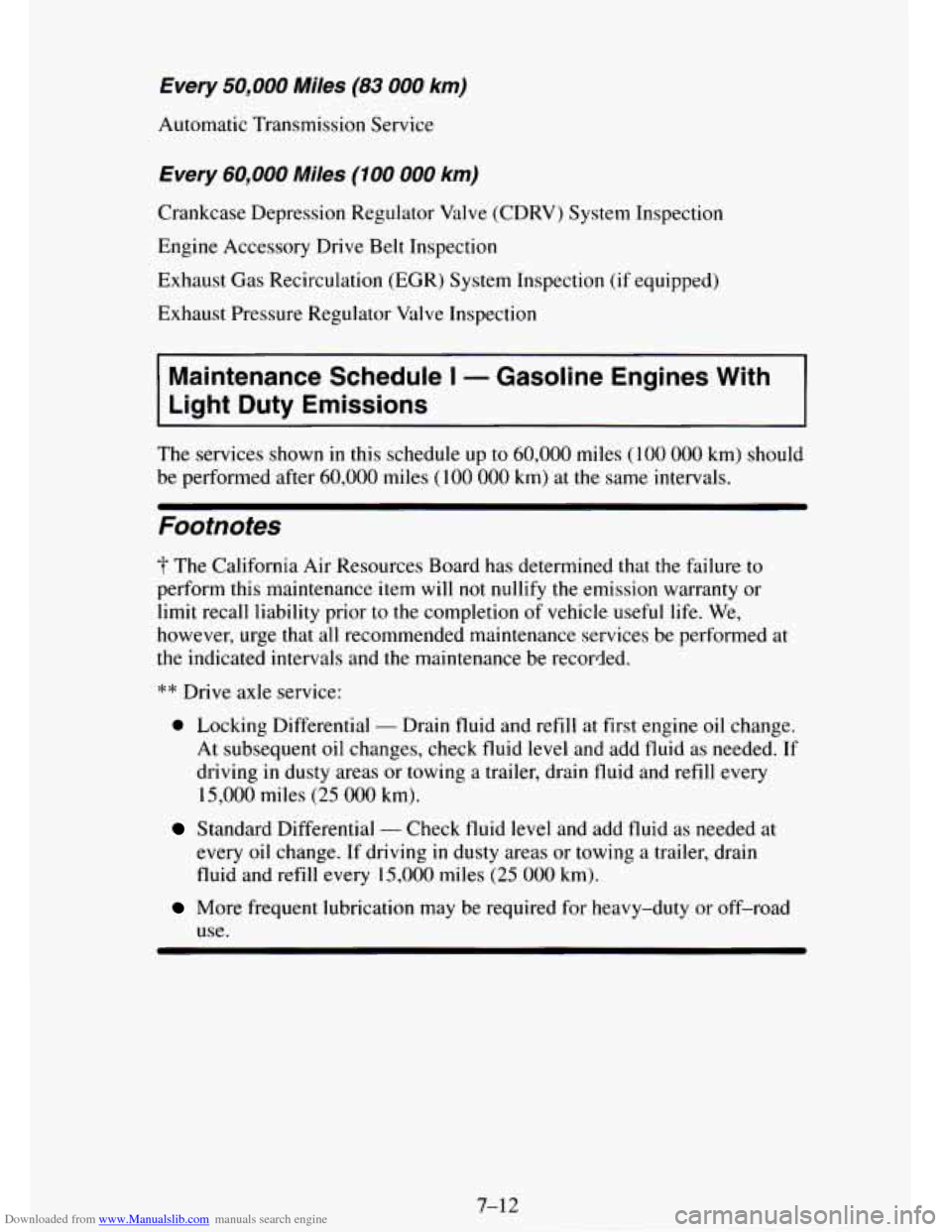
Downloaded from www.Manualslib.com manuals search engine Every 50,000 Miles (83 000 km)
Automatic Transmission Service
Every 60,000 Miles (100 000 km)
Crankcase Depression Regulator Valve (CDRV) System Inspection
Engine Accessory Drive Belt Inspection
Exhaust Gas Recirculation (EGR) System Inspection
(if equipped)
Exhaust Pressure Regulator Valve Inspection
Maintenance Schedule I - Gasoline Engines With
Light Duty Emissions
The services shown in this schedule up to 60,000 miles (100 000 km) should
be performed after
60,000 miles (100 000 km) at the same intervals.
Footnotes
The California Air Resources Board has determined that the failure to
perform this maintenance item will
not nullify the emission warranty or
limit recall liability prior
to the completion of vehicle useful life. We,
however, urge that all recommended maintenance services be performed at
the indicated intervals and the maintenance be recorded.
** Drive axle service:
0 Locking Differential - Drain fluid and refill at first engine oil change.
At subsequent oil changes, check fluid level and add fluid as needed. If
driving
in dusty areas or towing a trailer, drain fluid and refill every
15,000 miles (25 000 km).
Standard Differential - Check fluid level and add fluid as needed at
every
oil change. If driving in dusty areas or towing a trailer, drain
fluid and refill every
15,000 miles (25 000 km).
More frequent lubrication may be required for heavy-duty or off-road
use.
Page 387 of 486
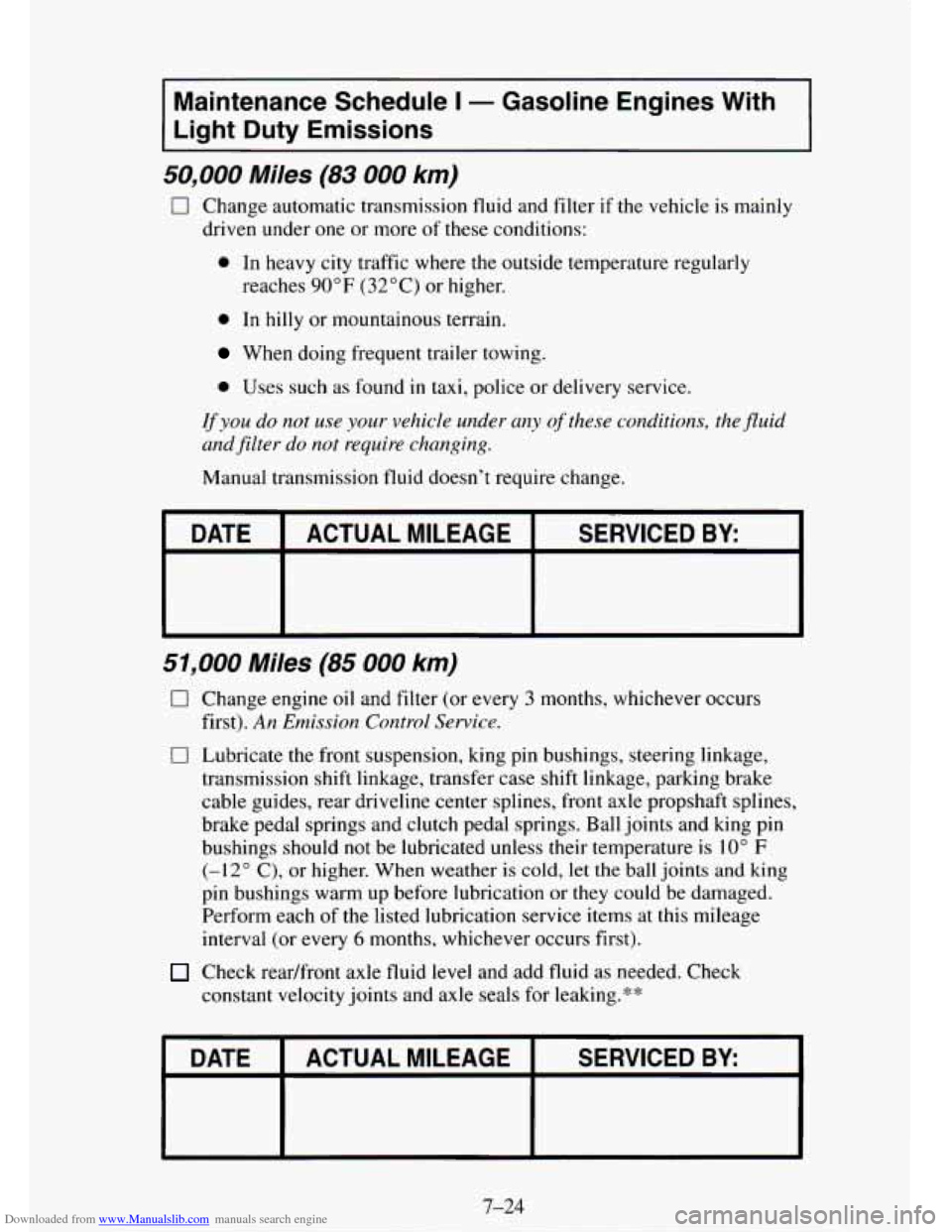
Downloaded from www.Manualslib.com manuals search engine Maintenance Schedule I - Gasoline Engines With
Light Duty Emissions
50,000 Miles (83 000 km)
0 Change automatic transmission fluid and filter if the vehicle is mainly
driven under one or more
of these conditions:
0 In heavy city traffic where the outside temperature regularly
reaches
90°F (32°C) or higher.
0 In hilly or mountainous terrain.
When doing frequent trailer towing.
0 Uses such as found in taxi, police or delivery service.
Ifyou do not use your vehicle under any ofthese conditions, the fluid
andfilter do not require changing.
Manual transmission fluid doesn't require change.
DATE SERVICED BY: ACTUAL MILEAGE
51,000 Miles (85 000 km)
0
0 Change engine oil and filter (or every 3 months, whichever occurs
first).
An Emission Control Service.
Lubricate the front suspension, king pin bushings, steering linkage,
transmission shift linkage, transfer case shift linkage, parking brake
cable guides, rear driveline center splines, front axle propshaft splines,
brake pedal springs and clutch pedal springs. Ball joints and king pin
bushings should not be lubricated unless their temperature
is 10" F
(-12" C), or higher. When weather is cold, let the ball joints and king
pin bushings warm up before lubrication or they could be damaged.
Perform each
of the listed lubrication service items at this mileage
interval (or every
6 months, whichever occurs first).
Check readfront axle fluid level and add fluid as needed. Check
constant velocity joints and axle seals for leaking.**
I DATE I ACTUALMILEAGE I SERVICED BY: I
Page 390 of 486
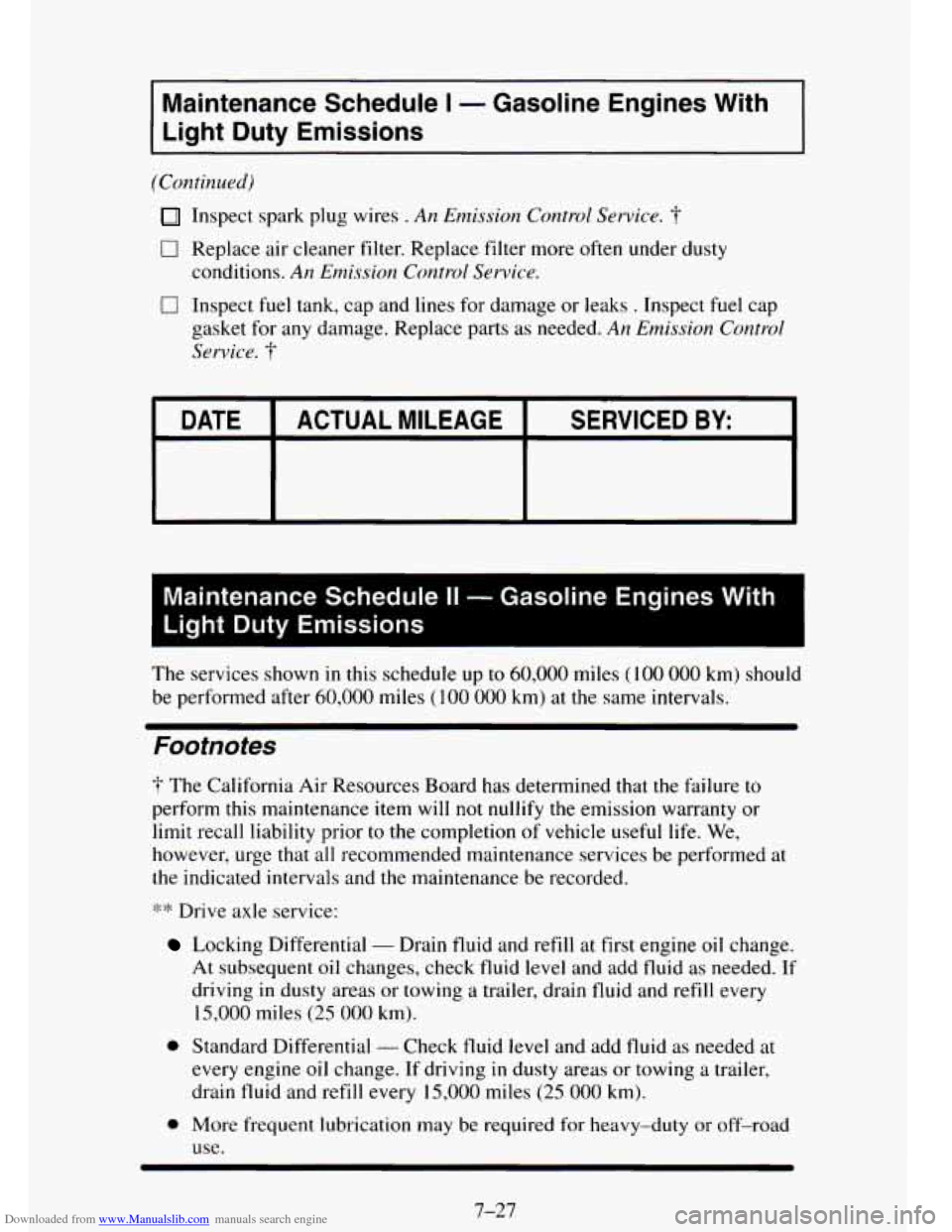
Downloaded from www.Manualslib.com manuals search engine Maintenance Schedule I - Gasoline Engines With
Light Duty Emissions
~~
(Continued)
0
0
Inspect spark plug wires . An Emission Control Service.
Replace air cleaner filter. Replace filter more often under dusty
conditions.
An Emission Control Service.
Inspect fuel tank, cap and lines for damage or leaks . Inspect fuel cap
gasket for any damage. Replace parts as needed. An
Emission Control
Sewice.
T
DATE SERVICED BY: ACTUAL MILEAGE
-
Maintenance Schedule II - Gasoline Engines With
Light Duty
Emissions
The services shown in this schedule up to 60,000 miles ( 100 000 km) should
be performed after
60,000 miles (I 00 000 km) at the same intervals.
Footnotes
T The California Air Resources Board has determined that the failure to
perform this maintenance item will not nullify the emission warranty or
limit recall liability prior
to the completion of vehicle useful life. We,
however, urge that all recommended maintenance services be performed at
the indicated intervals and the maintenance be recorded.
*4: Drive axle service:
Locking Differential - Drain fluid and refill at first engine oil change.
At subsequent oil changes, check fluid
level and add fluid as needed. If
driving
in dusty areas or towing a trailer, drain fluid and refill every
15,000 miles (25 000 km).
0 Standard Differential - Check fluid level and add fluid as needed at
every engine oil change. If driving in dusty areas or towing a trailer,
drain fluid and refill every
15,000 miles (25 000 km).
0 More frequent lubrication may be required for heavy-duty or off-road
use.
7-27
- .
Page 395 of 486
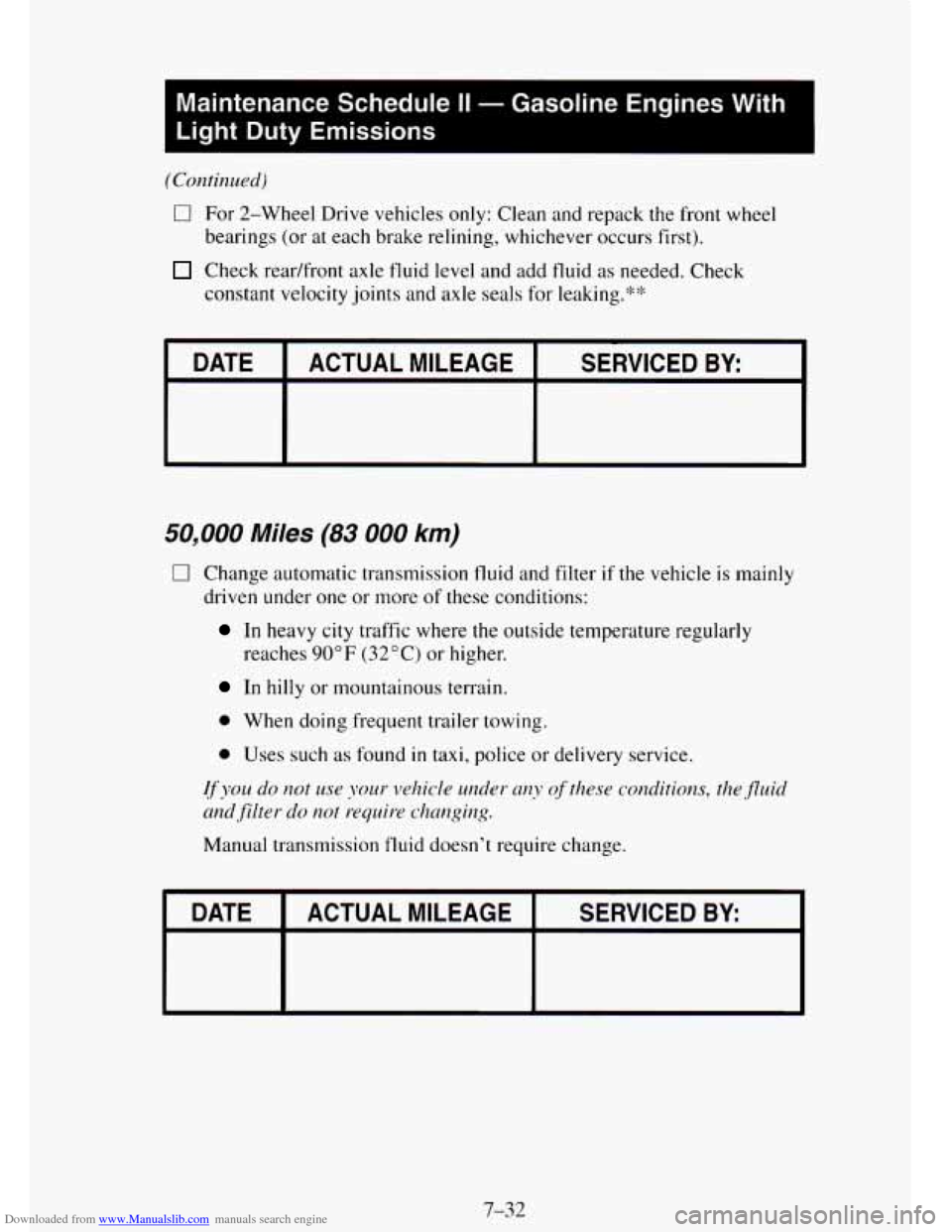
Downloaded from www.Manualslib.com manuals search engine Maintenance Schedule II - Gasoline Engines With
Light Duty Emissions
(Continued)
0 For 2-Wheel Drive vehicles only: Clean and repack the front wheel
bearings (or at each brake relining, whichever occurs first).
Check readfront axle fluid level and add fluid as needed. Check
constant velocity joints and axle seals for leaking.**
50,000 Miles (83 000 km]
0 Change automatic transmission fluid and filter if the vehicle is mainly
driven under one or more
of these conditions:
In heavy city traffic where the outside temperature regularly
reaches
90°F (32°C) or higher.
In hilly or mountainous terrain.
0 When doing frequent trailer towing.
0 Uses such as found in taxi, police or delivery service.
IJ' you do not use your vehicle under any of these conditions, the>fZuid
and filter do not require changing.
Manual transmission fluid doesn't require change.
ACTUAL MILEAGE I SERVICED BY I
7-32
Page 398 of 486
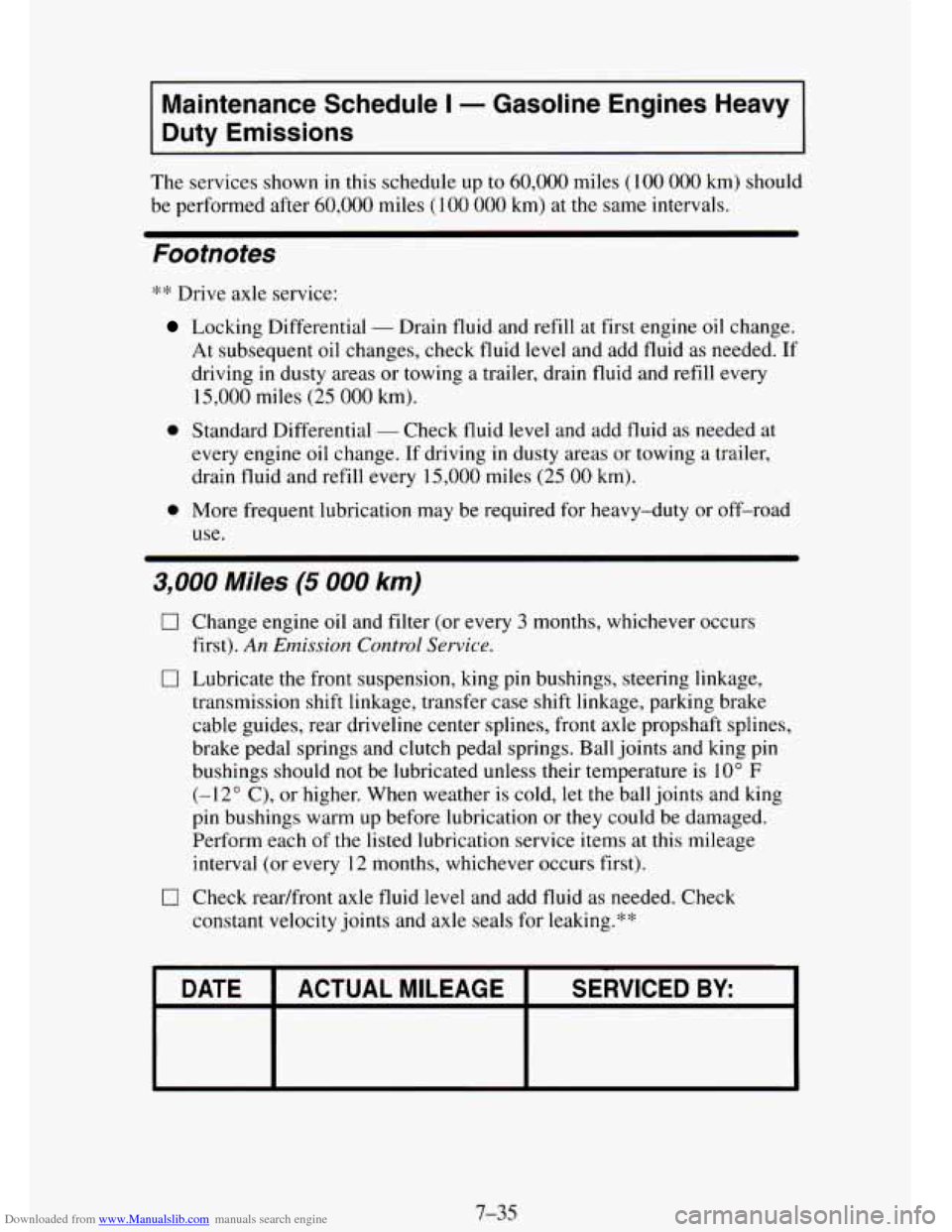
Downloaded from www.Manualslib.com manuals search engine Maintenance Schedule I - Gasoline Engines Heavy
Duty Emissions
The services shown in this schedule up to 60,000 miles (100 000 km) should
be performed after
60,000 miles (100 000 km) at the same intervals.
Footnotes
** Drive axle service:
Locking Differential - Drain fluid and refill at first engine oil change.
At subsequent oil changes, check fluid
level and add fluid as needed. If
driving
in dusty areas or towing a trailer, drain fluid and refill every
15,000 miles (25 000 km).
0 Standard Differential - Check fluid level and add fluid as needed at
every engine oil change. If driving in dusty areas or towing
a trailer,
drain fluid and refill every
15,000 miles (25 00 km).
0 More frequent lubrication may be required for heavy-duty or off-road
use.
3,000 Miles (5 000 km)
0 Change engine oil and filter (or every 3 months, whichever occurs
0 Lubricate the front suspension, king pin bushings, steering linkage,
transmission shift linkage, transfer case shift linkage, parking brake
cable guides, rear driveline center splines, front axle propshaft splines,
brake pedal springs and clutch pedal springs. Ball joints and king pin
bushings should
not be lubricated unless their temperature is 10" F
(-1 2" C), or higher. When weather is cold, let the ball joints and king
pin bushings warm up before lubrication or they could be damaged.
Perform each
of the listed lubrication service items at this mileage
interval (or every 12 months, whichever occurs first).
first).
An Emission Control Service.
0 Check
readfront axle fluid level and add fluid as needed. Check
constant velocity joints and
axle seals for leaking.**
DATE SERVICED BY ACTUAL MILEAGE
7-35
Page 411 of 486
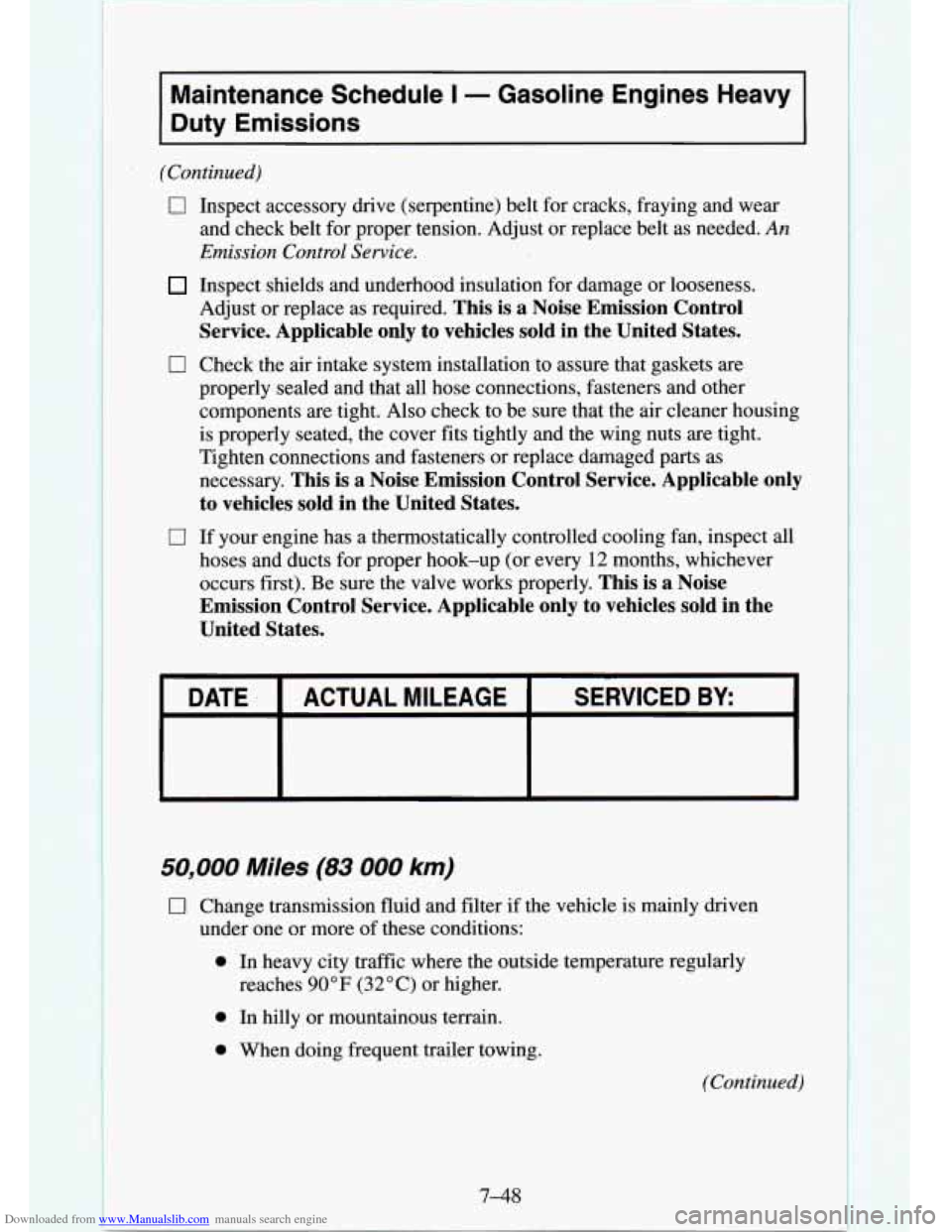
Downloaded from www.Manualslib.com manuals search engine Maintenance Schedule I - Gasoline Engines Heavy
Duty Emissions
(Continued)
0
0
0
Inspect accessory drive (serpentine) belt for cracks, fraying and wear
and check belt for proper tension. Adjust or replace belt as needed.
An
Emission Control Service.
Inspect shields and underhood insulation for damage or looseness.
Adjust or replace as required.
This is a Noise Emission Control
Service. Applicable only to vehicles sold in the United States.\
Check the air intake system installation to assure that gaskets are
properly sealed and that all hose connections, fasteners and other
components are tight. Also check to be sure that the air cleaner housing
is properly seated, the cover fits tightly and the wing nuts are tight.
Tighten connections and fasteners or replace damaged parts as
necessary.
This is a Noise Emission Control Service. Applicable only
to vehicles sold in the United States.
If your engine has a thermostatically controlled cooling fan, inspect all
hoses and ducts for proper hook-up (or every
12 months, whichever
occurs first). Be sure the valve works properly.
This is a Noise
Emission Control Service. Applicable only to vehicles sold in t\
he
United States.
I DATE' I ACTUALMILEAGE I SERVICED BY: I
50,000 Miles (83 000 km)
0 Change transmission fluid and filter if the vehicle is mainly driven
under one or more
of these conditions:
a In heavy city traffic where the outside temperature regularly
reaches
90°F (32°C) or higher.
a In hilly or mountainous terrain.
a When doing frequent trailer towing.
(Continued)
7-48
1